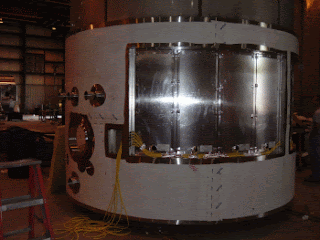 |
Induction heating coils around large pipe
in preparation of welding. |
The principles of
induction heating have been applied to manufacturing operations since the 1930s, when the first channel-type induction furnaces were introduced for metals melting operations. Soon afterward, coreless induction furnaces were developed for melting, superheating, and holding. In the 1940s, the technology was also used to harden metal engine parts. More recently, an emphasis on improved quality control has led to increased use of induction technology in the ferrous and nonferrous metals industries.
In a basic induction heating setup, a solid state power supply sends an alternating current (AC) through a copper coil, and the part to be heated is placed inside the coil. When a metal part is placed within the coil and enters the magnetic eld, circulating eddy currents are induced within the part. These currents ow against the electrical resistivity of the metal, generating precise and localized heat without any direct contact between the part and the coil.
An induction furnace induces an electric current in the material to be melted, creating eddy currents which dissipate energy and produce heat. The current is induced by surrounding the material with a wire coil carrying an electric current. When the material begins to melt, electromagnetic forces agitate and mix it. Mixing and melting rates can be controlled by varying the frequency and power of the current in the wire coil. Coreless furnaces have a refractory crucible surrounded by a water-cooled AC current coil. Coreless induction furnaces are used primarily for remelting in foundry operations and for vacuum refining of specialty metals.
Channel furnaces have a primary coil wound on a core. The secondary side of the core is in the furnace interior, surrounded by a molten metal loop. Channel furnaces are usually holding furnaces for nonferrous metals melting, combined with a fuel- red cupola, arc, or coreless induction furnace, although they are also used for melting as well.
The efficiency of an induction heating system for a specific application depends on several factors: the characteristics of the part itself, the design of the induction coil, the capacity of the power supply, and the degree of temperature change required for the application.
Induction heating works directly with conductive materials only, typically metals. Plastics and other nonconductive materials often can be heated indirectly by first heating a conductive metal medium that transfers heat to the nonconductive material.
With conductive materials, about 80% of the heating effect occurs on the surface or “skin” of the part. The heating intensity diminishes as the distance from the surface increases, so small or thin parts generally heat more quickly than large thick parts, especially if the larger parts need to be heated all the way through.
Induction heating can also be used to heat liquids in vessels and pipelines, primarily in the petrochemical industry. Induction heating involves no contact between the material being heating and the heat source, which is important for some operations. This lack of contact facilitates automation of the manufacturing processes. Other examples include heat treating, curing of coatings, and drying.
Induction heating often is used where repetitive operations are performed. Once an induction system is calibrated for a part, work pieces can be loaded and unloaded automatically. Induction systems are often used in applications where only a small selected part of a work piece needs to be heated. Because induction systems are clean and release no emissions, sometimes a part can be hardened on an assembly line without having to go to a remote heat treating operation.











